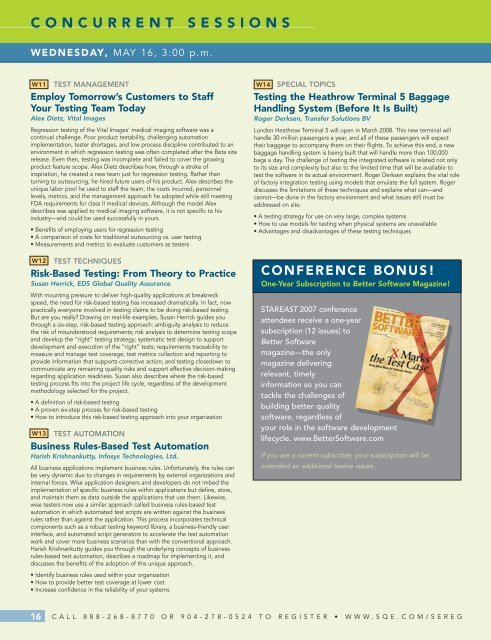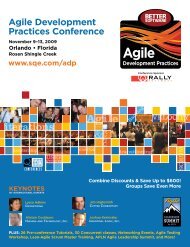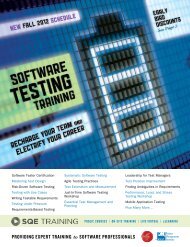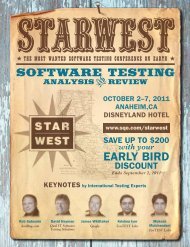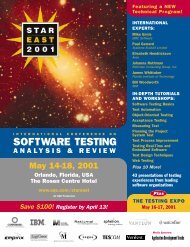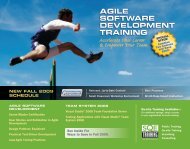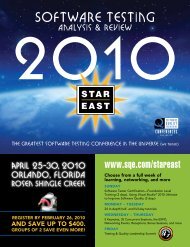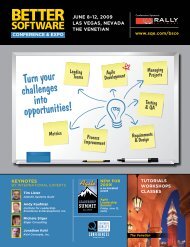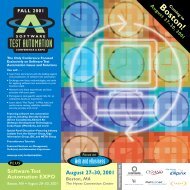CONCURRENT SESSIONSWEDNESDAY, MAY 16, 3:00 p.m.W11TEST MANAGEMENTEmploy Tomorrow’s Customers to StaffYour Testing Team TodayAlex Dietz, Vital ImagesRegression testing of the Vital Images’ medical imaging software was acontinual challenge. Poor product testability, challenging automationimplementation, tester shortages, and low process discipline contributed to anenvironment in which regression testing was often <strong>com</strong>pleted after the Beta siterelease. Even then, testing was in<strong>com</strong>plete and failed to cover the growingproduct feature scope. Alex Dietz describes how, through a stroke ofinspiration, he created a new team just for regression testing. Rather thanturning to outsourcing, he hired future users of his product. Alex describes theunique labor pool he used to staff the team, the costs incurred, personnellevels, metrics, and the management approach he adopted while still meetingFDA requirements for class II medical devices. Although the model Alexdescribes was applied to medical imaging software, it is not specific to hisindustry—and could be used successfully in yours.• Benefits of employing users for regression testing• A <strong>com</strong>parison of costs for traditional outsourcing vs. user testing• Measurements and metrics to evaluate customers as testersW12TEST TECHNIQUESRisk-Based Testing: From Theory to PracticeSusan Herrick, EDS Global Quality AssuranceWith mounting pressure to deliver high-quality applications at breakneckspeed, the need for risk-based testing has increased dramatically. In fact, nowpractically everyone involved in testing claims to be doing risk-based testing.But are you really? Drawing on real-life examples, Susan Herrick guides youthrough a six-step, risk-based testing approach: ambiguity analysis to reducethe risk of misunderstood requirements; risk analysis to determine testing scopeand develop the “right” testing strategy; systematic test design to supportdevelopment and execution of the “right” tests; requirements traceability tomeasure and manage test coverage; test metrics collection and reporting toprovide information that supports corrective action; and testing closedown to<strong>com</strong>municate any remaining quality risks and support effective decision-makingregarding application readiness. Susan also describes where the risk-basedtesting process fits into the project life cycle, regardless of the developmentmethodology selected for the project.• A definition of risk-based testing• A proven six-step process for risk-based testing• How to introduce this risk-based testing approach into your organizationW13TEST AUTOMATIONBusiness Rules-Based Test AutomationHarish Krishnankutty, Infosys Technologies, Ltd.All business applications implement business rules. Unfortunately, the rules canbe very dynamic due to changes in requirements by external organizations andinternal forces. Wise application designers and developers do not imbed theimplementation of specific business rules within applications but define, store,and maintain them as data outside the applications that use them. Likewise,wise testers now use a similar approach called business rules-based testautomation in which automated test scripts are written against the businessrules rather than against the application. This process incorporates technical<strong>com</strong>ponents such as a robust testing keyword library, a business-friendly userinterface, and automated script generators to accelerate the test automationwork and cover more business scenarios than with the conventional approach.Harish Krishnankutty guides you through the underlying concepts of businessrules-based test automation, describes a roadmap for implementing it, anddiscusses the benefits of the adoption of this unique approach.• Identify business rules used within your organization• How to provide better test coverage at lower cost• Increase confidence in the reliability of your systemsW14SPECIAL TOPICSTesting the Heathrow Terminal 5 BaggageHandling System (Before It Is Built)Roger Derksen, Transfer Solutions BVLondon Heathrow Terminal 5 will open in March 2008. This new terminal willhandle 30 million passengers a year, and all of these passengers will expecttheir baggage to ac<strong>com</strong>pany them on their flights. To achieve this end, a newbaggage handling system is being built that will handle more than 100,000bags a day. The challenge of testing the integrated software is related not onlyto its size and <strong>com</strong>plexity but also to the limited time that will be available totest the software in its actual environment. Roger Derksen explains the vital roleof factory integration testing using models that emulate the full system. Rogerdiscusses the limitations of these techniques and explains what can—andcannot—be done in the factory environment and what issues still must beaddressed on site.• A testing strategy for use on very large, <strong>com</strong>plex systems• How to use models for testing when physical systems are unavailable• Advantages and disadvantages of these testing techniquesCONFERENCE BONUS!One-Year Subscription to Better Software Magazine!STAREAST 2007 conferenceattendees receive a one-yearsubscription (12 issues) toBetter Softwaremagazine—the onlymagazine deliveringrelevant, timelyinformation so you cantackle the challenges ofbuilding better qualitysoftware, regardless ofyour role in the software developmentlifecycle. www.BetterSoftware.<strong>com</strong>If you are a current subscriber, your subscription will beextended an additional twelve issues.16 CALL 888-268-8770 OR 904-278-0524 TO REGISTER • WWW.<strong>SQE</strong>.COM/SEREG
CONCURRENT SESSIONSMONDAY, MAY 16, 8:30-5:00THURSDAY, MAY 17, 9:45 a.m.T1TEST MANAGEMENTCrucial Test ConversationsRobert Galen, RGCG, LLC.Many test managers feel that Development or Management or The Businessdoes not understand or support the contributions of their test teams. You knowwhat? They’re probably right! However, once we accept that fact, we should ask:Why? Bob Galen believes that it is our inability and ineffectiveness at 360º<strong>com</strong>munications, in other words, “selling” ourselves, our abilities and ourcontribution. We believe that our work should speak for itself or that everyoneshould inherently understand our worth. Wrong! We need to work hard to createcrucial conversations in which we <strong>com</strong>municate our impact on the product andthe organization. Bob shares with you specific techniques for improving the<strong>com</strong>munication skills of test managers and testers so that others in yourorganization will better understand your role and contributions. He also focuseson improving your cross-team <strong>com</strong>munication and feedback skills—a key tocreating highly effective teams. Come prepared to engage and <strong>com</strong>municate.• High impact “conversations” to effectively <strong>com</strong>municate your test team’s worth• How to craft better status reports to tell your story• Effective feedback conversations to improve individual performanceT2TEST TECHNIQUESTesting Requirements: Ensuring QualityBefore the Coding BeginsJoe Marasco, RavenflowSoftware that performs well is useless if it ultimately fails to meet user needsand requirements. Requirements errors are the number one cause of softwareproject failures, yet many organizations continue to create requirementsspecifications that are unclear, ambiguous, and in<strong>com</strong>plete. What's theproblem? All too often, requirements quality gets lost in translation betweenbusiness people who think in words and software architects and engineers whoprefer visual models. Joe Marasco discusses practical approaches for testingrequirements to verify that they are as <strong>com</strong>plete, accurate, and precise aspossible—a process that requires new, collaborative approaches torequirements definition, <strong>com</strong>munication, and validation. Additionally, Joeexplores the challenges of developing “requirements-in-the-large,” by involvinga broad range of stakeholders—analysts, developers, business executives, andsubject matter experts—in a process <strong>com</strong>plicated by continual change.• Why many <strong>com</strong>mon requirements specification techniques fail• Bridging the gap between requirements written in prose and visual models• Measures of requirements qualityT3TEST AUTOMATIONDouble-Track SessionKeyword-Driven Test Automation IlluminatedMark Fewster, Grove ConsultantsTest Automation has <strong>com</strong>e a long way in the last twenty years. During that timemany of today's most popular test execution automation tools have <strong>com</strong>e intouse, and a variety of implementation methods have been tried and tested. Manysuccessful organizations began their automation effort with a data-driven approachand enhanced their efforts into what is now called keyword-driven testautomation. Many versions of the keyword-driven test execution concept havebeen implemented. Some are difficult to distinguish from their data-drivenpredecessors. So what is keyword-driven test automation? Mark Fewster providesan objective analysis of keyword-driven test automation by examining the variousimplementations, the advantages and disadvantages of each, and the benefitsand pitfalls of this automation concept. Find out if keyword-driven test automationis what you are looking for or if it is an empty promise for your test organization.• Differences between data-driven and keyword-driven test automation• Benefits and drawbacks of keyword-driven testing• Alternative keyword-driven automation implementationsT4MODEL-BASED <strong>TESTING</strong>Build a Model-Based Testing Frameworkfor Dynamic AutomationBen Simo, Standard & Poor’sThe promises of faster, better, and cheaper testing through automation arerarely realized. Most test automation scripts simply repeat the same test stepsevery time. Join Ben Simo as he shares his answers to some thought-provokingquestions: What if your automated tests were easier to create and maintain?What if your test automation could go where no manual tester had gonebefore? What if your test automation could actually create new tests? Ben saysmodel-based testing can. With model-based testing, testers describe thebehavior of the application under test and let <strong>com</strong>puters generate and executethe tests. Instead of writing test cases, the tester can focus more on theapplication's behavior. A simple test generator then creates and executes testsbased on the application’s modeled behavior. When an application changes,the behavioral model is updated rather than manually changing all the testcases impacted by the change.• Definition and benefits of model-based testing• How to create a framework to support your model-based testing• Model behavior rather than write static testsT5SPECIAL TOPICSLightning Talks: A Potpourri of 5-MinutePresentationsFacilitated by Matt Heusser, Priority HealthLightning TalksLightning Talks are nine five-minute talks in a fifty-minute time period.Lightning Talks represent a much smaller investment of time than trackspeaking and offer the chance to try conference speaking without the heavy<strong>com</strong>mitment. Lightning Talks are an opportunity to present your single,biggest bang-for-the-buck idea quickly. Use this as an opportunity to give afirst time talk or to present a new topic for the first time. Maybe you just wantto ask a question, invite people to help you with your project, boast aboutsomething you did, or tell a short cautionary story. These things are allinteresting and worth talking about, but there might not be enough to sayabout them to fill up a full track presentation. For more information on how tosubmit a Lightning Talk, visit www.sqe.<strong>com</strong>/lightningtalks. Hurry! Thedeadline for submissions is March 26, 2007.“I really enjoyedthe conference.I gained a lot ofindustry knowledgeand look forward to<strong>com</strong>ing back.”— Mike Persi, IT-SQA SupervisorMercury Insurance GroupCALL 888-268-8770 OR 904-278-0524 TO REGISTER • WWW.<strong>SQE</strong>.COM/SEREG 17
- Page 1 and 2: SOFTWARE TESTING ANALYSIS & REVIEWO
- Page 3 and 4: THE TESTING EXPOMay 16-17, 2007Visi
- Page 5 and 6: AT-A-GLANCE8:30Test Estimation: A P
- Page 7 and 8: SPECIAL EVENTSAttend a Special Even
- Page 9 and 10: PRECONFERENCE TUTORIALSMONDAY, MAY
- Page 11 and 12: PRECONFERENCE TUTORIALSTUESDAY, MAY
- Page 13 and 14: KEYNOTE SESSIONSMONDAY, MAY 16, 8:3
- Page 15: CONCURRENT SESSIONSMONDAY, MAY 16,
- Page 19 and 20: CONCURRENT SESSIONSMONDAY, MAY 16,
- Page 21 and 22: CONCURRENT SESSIONSMONDAY, MAY 16,
- Page 23 and 24: STAREAST 2007 REGISTRATION INFORMAT


